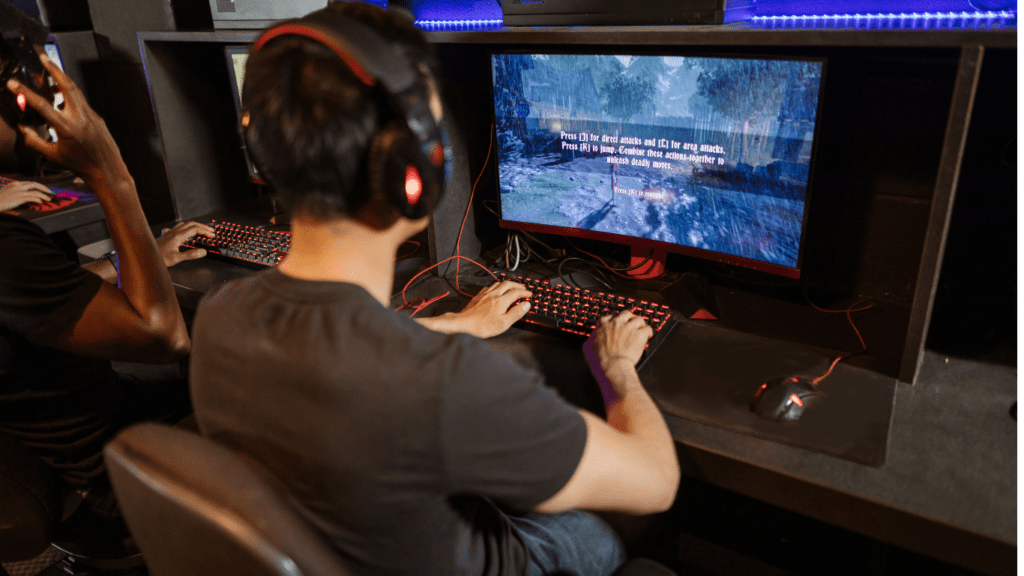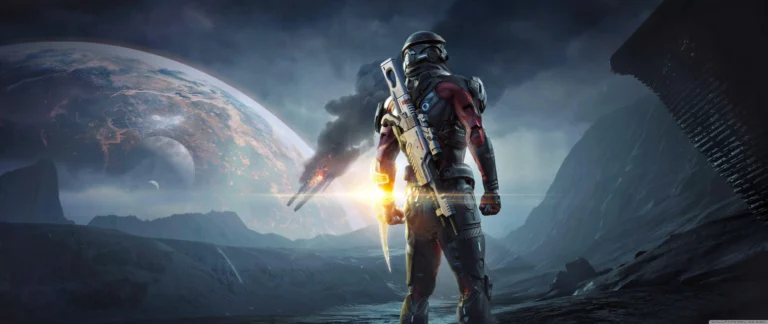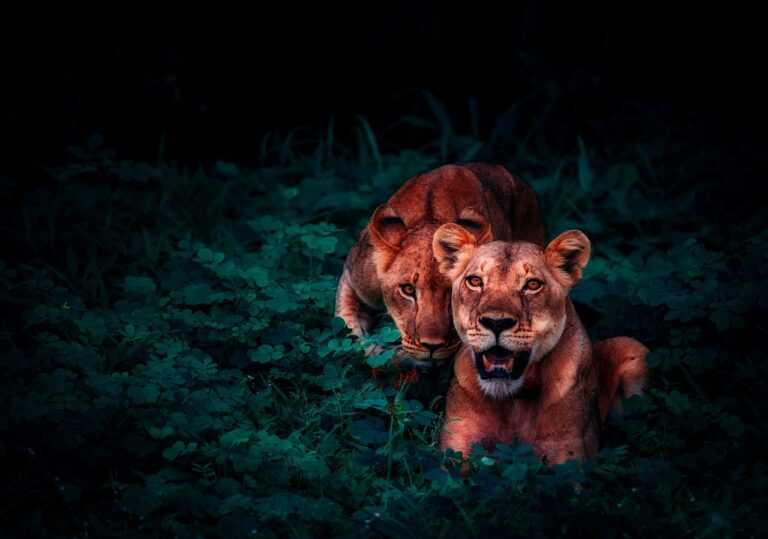The Rise of Cinematic Video Games
Historical Evolution of Game Narratives
Game narratives have evolved significantly. Early games like “Pac-Man” (1980) focused on simple, repetitive tasks with minimal storytelling.
As technology advanced, so did the complexity of narratives.
By the late ’90s, titles like “Final Fantasy VII” incorporated intricate plots, character development, and emotional depth.
These changes laid the groundwork for modern games, which often feature storylines rivaling those of blockbuster movies.
Key Milestones in Graphical Advancements
Graphical advancements have played a crucial role in making video games more cinematic.
In 1996, “Tomb Raider” introduced 3D character models, adding a new dimension (literally) to game design and aesthetics.
The launch of Unreal Engine in 1998 revolutionized real-time rendering, enabling realistic environments and lighting effects.
Recent milestones like the ray tracing in “Cyberpunk 2077” (2020) allow for movie-quality visuals, blurring the lines between films and games.
How Movies Influence Game Design
Narrative Techniques Borrowed from Cinema
Game designers pull from cinematic storytelling methods to craft deeper, engaging narratives such as:
- Mass Effect
- Pulp Fiction
- The Last of Us
- The Walking Dead
Voice acting, once rare in games, now brings characters to life with emotional depth, much like actors in films do.
Dialogue trees in games like “Mass Effect” mimic the nuanced conversations found in movies, offering players choices that shape the narrative.
Flashbacks and nonlinear storytelling, seen in films like “Pulp Fiction,” appear in games such as “The Last of Us,” providing a richer, more complex narrative structure.
Cliffhangers and episodic content, inspired by television series, are used in game franchises like “The Walking Dead” to keep players engaged over time.
Visual Styles and Techniques Translated into Gaming
Filmmakers’ visual techniques translate into game design, enriching the visual experience.
Motion capture technology, used in films like “Avatar,” appears in games such as “Red Dead Redemption 2,” leading to lifelike character movements.
Cinematic camera angles and depth of field effects, prevalent in movies, enhance visual storytelling in games like “God of War.” Color grading and lighting, crucial in films like “Blade Runner,” influence the atmospheric and aesthetic choices in games like “Cyberpunk 2077.”
Advanced visual effects, including real-time ray tracing, push the boundaries of realism in games, making them visually resonate like their cinematic counterparts.
Significant Collaborations Between Filmmakers and Game Developers
Case Studies of Successful Collaborations
- Hideo Kojima and Guillermo del Toro: The collaboration between game designer Hideo Kojima and filmmaker Guillermo del Toro has produced notable ventures such as “Death Stranding.” Del Toro contributed to the game’s narrative depth and character development, elevating it to cinematic standards.
Del Toro’s background in film helped in crafting a visually compelling story that resonated well with gamers and film enthusiasts alike. - Neill Blomkamp and Bioware: Neill Blomkamp, known for his work in films like “District 9,” collaborated with Bioware to create live-action trailers for their game “Anthem.”
Blomkamp’s expertise in visual storytelling brought an immersive quality to the game’s promotional content, making it a notable example of successful cross-industry collaboration. - George Lucas and LucasArts: George Lucas’ involvement with LucasArts led to the creation of “Star Wars” games that closely paralleled the narrative and visual style of his films.
Lucas’ influence ensured that games like “Star Wars: Knights of the Old Republic” maintained authenticity and captured the essence of the original film franchise.
Impact on Gaming Culture and Communities
- Enhanced Storytelling: Collaborations have driven game storytelling to new heights. Complex narratives similar to those in films have become standard.
Games now feature intricate dialogue, character arcs, and plot twists, attracting a wider audience and deepening player engagement. - Cultural Convergence: Cross-industry projects have bridged the gap between film and gaming cultures. Fans of a filmmaker’s work are often drawn to games they’re involved in, leading to a merging of fan communities.
This convergence has enriched the overall entertainment experience for both gamers and moviegoers. - Increased Production Value: Filmmaker collaborations have significantly boosted the production values of games. Advanced motion capture, realistic CGI, and high-quality voice acting are now common, enhancing the immersive experience.
Games often feel like interactive movies due to these high production standards. - Community Engagement: Directors and developers often engage with fan communities through social media and events, creating a sense of inclusion and community.
This engagement fosters loyalty and generates excitement for upcoming projects. Active collaboration often results in fan-driven content and discussions, further extending the game’s lifecycle.
Future Trends in the Intersection of Film and Gaming
Predictions for Technological Innovations
Cutting-edge technologies like virtual reality (VR) and augmented reality (AR) are set to transform how films influence game design.
VR and AR provide immersive experiences by blending digital content with the physical environment.
For example, “Star Wars: Squadrons” uses VR to put players in the cockpit of iconic starfighters, creating a deeply engaging experience.
AI advancements could further revolutionize game narratives, making them more dynamic.
Predictive algorithms can adapt storyline progression based on player choices, offering personalized experiences that mimic complex movie plots.
Potential New Genres and Gameplay Mechanics
Innovative genres and gameplay mechanics at the intersection of film and gaming are likely to emerge.
Interactive movies, where players make choices influencing the storyline, blend cinematic storytelling with gaming.
Games like “Bandersnatch” already showcase this hybrid approach. Additionally, episodic game releases, akin to TV series, could gain traction.
Players would engage with a story over several “episodes,” similar to watching a TV show.
This methodology maintains player interest over time.
Furthermore, the integration of motion capture and photorealistic graphics promises to enhance character authenticity and emotional depth, drawing players deeper into the narrative.















































































































 Darcy Cazaly is a key contributor at Infinity Game Saga, where he brings his expertise to the world of gaming journalism. As a dedicated member of the team, Darcy focuses on delivering in-depth articles and insightful analyses that cover a broad range of topics within the gaming industry. His work includes exploring the latest trends, dissecting game mechanics, and providing thorough reviews of new releases.
Darcy's commitment to high-quality content ensures that readers receive accurate and engaging information about the evolving gaming landscape. His writing not only informs but also enriches the gaming experience for the community, offering valuable perspectives and up-to-date news. Through his contributions, Darcy helps bridge the gap between gamers and the dynamic world of gaming technology and trends, making him an essential part of the Infinity Game Saga team.
Darcy Cazaly is a key contributor at Infinity Game Saga, where he brings his expertise to the world of gaming journalism. As a dedicated member of the team, Darcy focuses on delivering in-depth articles and insightful analyses that cover a broad range of topics within the gaming industry. His work includes exploring the latest trends, dissecting game mechanics, and providing thorough reviews of new releases.
Darcy's commitment to high-quality content ensures that readers receive accurate and engaging information about the evolving gaming landscape. His writing not only informs but also enriches the gaming experience for the community, offering valuable perspectives and up-to-date news. Through his contributions, Darcy helps bridge the gap between gamers and the dynamic world of gaming technology and trends, making him an essential part of the Infinity Game Saga team.
